
In 1847 Edgar’s father, James Harwood 1825-1881, had established a whitesmith business, James Harwood and Sons. James’s father, William, Edgar’s grandfather 1794-1868 had also been a whitesmith, as had his great grandfather John 1753-1803 and his great great grandfather John born in 1703. For at least five generations the family had lived on Height Road, in a smaller cluster of houses comprising Foster Clough. Heights Road hugs the 300 metre contour line and Foster Clough is a small but active stream that bustles down the hillside. The stream is mirrored on the other side of the valley by Cragg Brook. In fact Foster Clough is exactly opposite Frost Hole and Bell House on the same contour. I took advantage of the only day in the weather forecast to not be either snowing or raining heavily to take another trip up to Heights Road now that I knew of its connection with my family’s story.
Taking the zippy bus up the steep 600 ft gradient from the valley to Heights Road I alighted to what feels like an aerial view of the Calder valley with its spectacular views across the neighbouring moorland for over 30 miles.

The valley’s narrowness at Hebden Bridge widens out into the gentler area around Mytholmroyd which means a clearing where two rivers meet in Old English. The first building on my left is Mt Skip, now a B and B and the owner was working on the garden as I passed. We chatted for a few minutes about the impact of the pandemic on her business and I mentioned that I’d love to stay there when it was eventually possible.
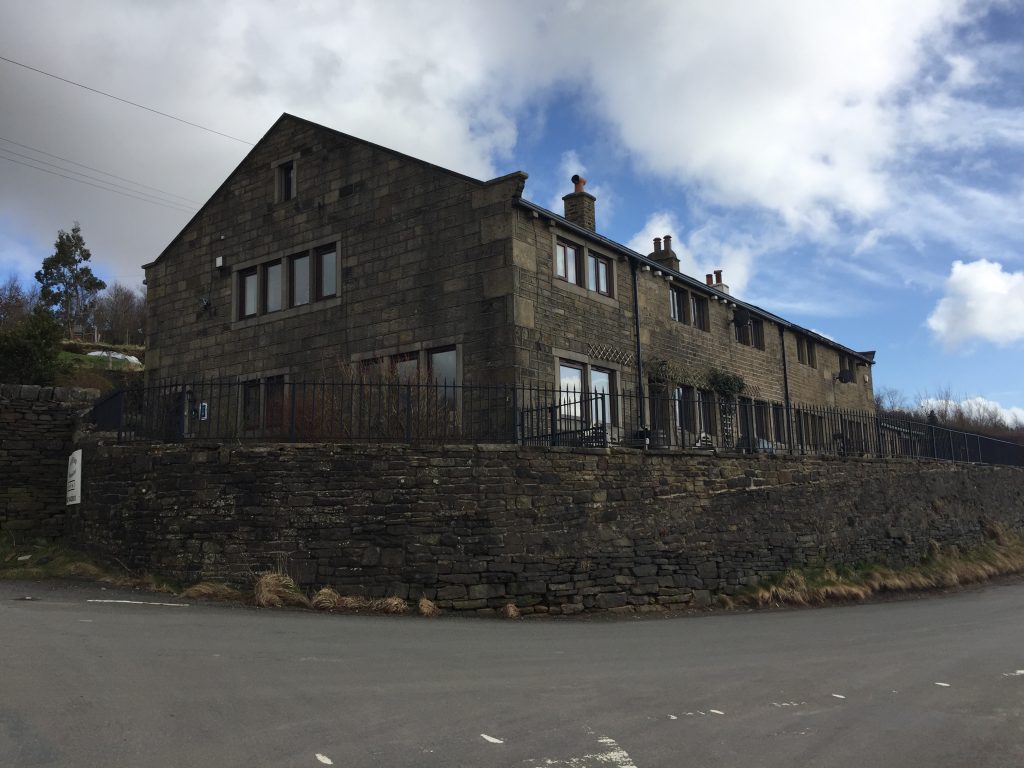
Mount Skip was built in 1718 as a drovers inn, serving the pack horse and mule drovers who took wool and cloth on the journey to and from the markets in Halifax. It served as a hostelry for around 200 years until it closed as a pub in 1999. Where did its customers come from? There’s no village, or even other houses close by. With the advent of the motor car I can understand that people would like ‘a run out’, to a place with such a magnificent view, especially in the evenings. But how did it survive pre motor car? It wasn’t until I reached home that I discovered that for more than 50 years, beginning around 1850 the innkeepers of Mt Skip had been three members of the Harwood family. It seemed to be too much of a coincidence that the Mt Skip innkeepers could be anything other than members of ‘my’ Harwood family. Was this entire area inhabited by Harwoods? Indeed. In the 1851 census of the seven households closest to Mt Skip six of them were lived in by Harwoods! I followed Heights Road eastward. To my right a few sheep were huddling together to keep warm on this icy afternoon. In the next field a Highland cow said Hello to me.

Below them the hill dropped steeply to Raw Lane and then Burlees Lane, paralleling Heights Road and then a steeper descent through the woods led to the valley floor. To my left however, a more gradual slope leads to the top of Wadsworth Moor, its outcrops of sandstone standing like sentinels above the smooth lawns of Mt Skip golf course. This area is scattered with delphs, the local word for quarries, and a new word for me which I learned while chatting to the owner of Foster Clough farm a few minutes later. But first I came to the next group of two adjoining cottages. When I’d first seen the house’s name on a sign by the entrance on a walk along Heights Road two years ago I’d stopped to take a photo, as, I’m sure many people do. Of course, it was named Rough Bottom to distinguish it from Rough Top, the farm just a few metres away and about 50 ft higher.
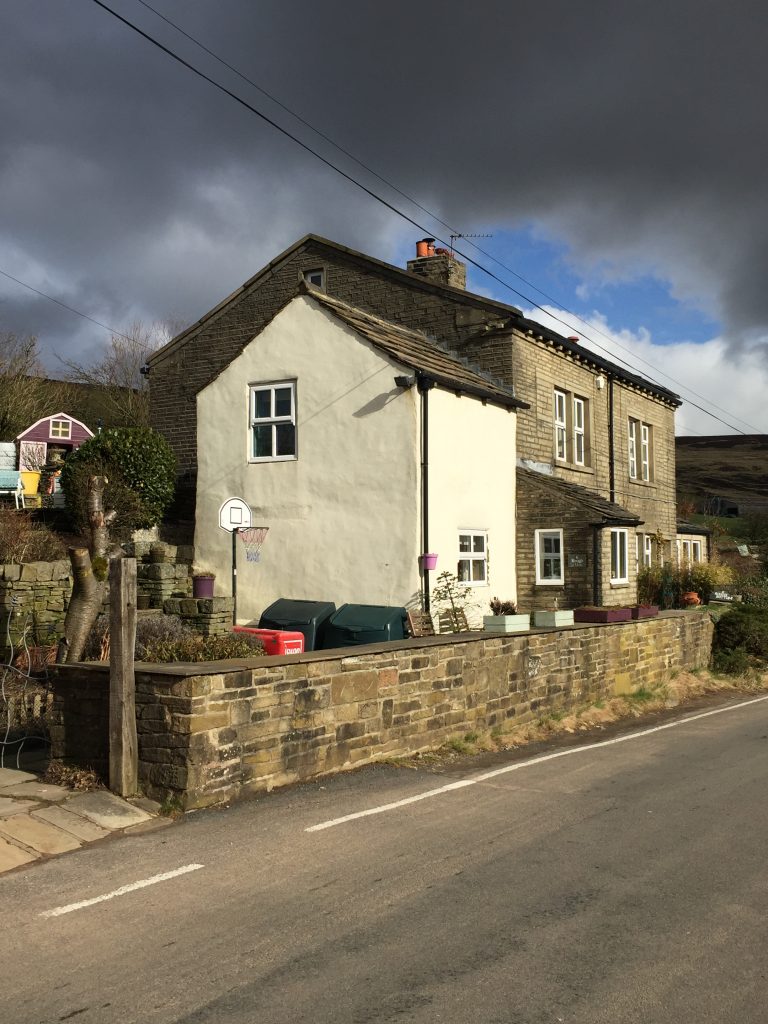

There was a lovely garden in full bloom that day and I saw that the garden was listed in the Open Gardens event at the Hebden Bridge festival in 2006. In 1841 the two cottages were the home of John Harwood, a whitesmith, his wife Martha and their six children ranging in age from 20 to 5. The far east end of the building is recessed and David Cant two years ago when I asked him about the job of a whitesmith in connection with Samuel Gibson told me that this had been the site of the smithy itself. High Rough farm still stands on the hill above Rough Bottom and in 1841 this was the home of Mary Harwood, a 55 year old farmer of 14 acres, with her daughter Mary Greenwood, 30, a dressmaker and 2 year old Heaton Greenwood. In the 1861 census Rough is uninhabited. I followed the path up towards the farm. It’s surrounded by outbuildings, sheds, tractors and carts holding a variety of farm implements but I couldn’t see anyone around so I decided not to go right up to the farm building.
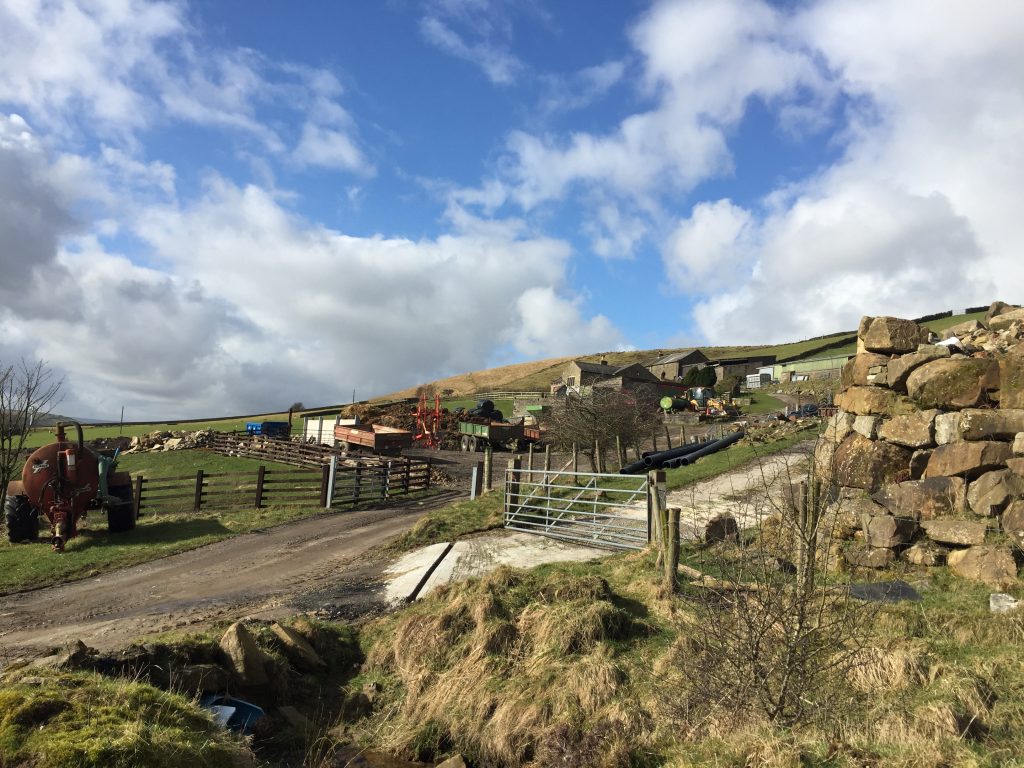

Rough Bottom and High Rough lie a mile to the west of the ancient hilltop village of Midgley but before I reached the village I came to a bridge crossing Foster Clough, a turbulent stream, bordered by trees. Adjacent to the bridge on my left was a house right on the roadside but hidden a little by the trees.
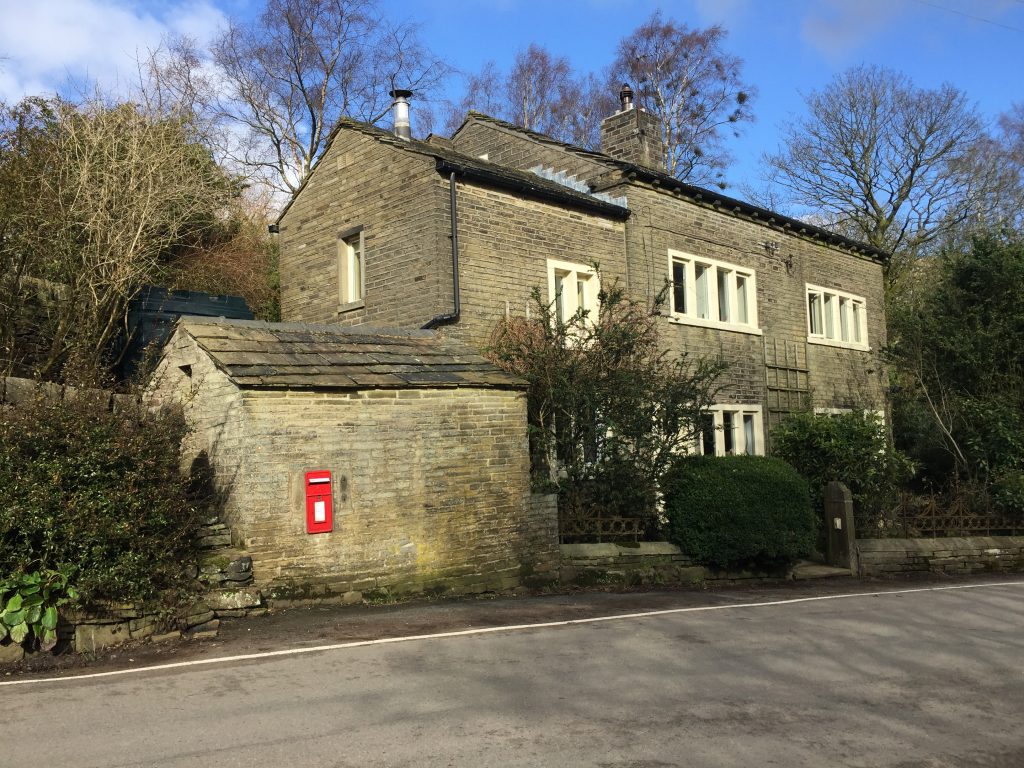

This was Foster Clough House. It even has a red postbox inserted into its wall. In 1841 this lovely house was the home of William and Mary Harwood. William had been born in 1794 at High Rough, the son of John and Betty (nee Jackson) of Rugh. (Note the spelling) William, a whitesmith, had married Mary Wormwald in 1816. They had ten children between 1821 and 1840. I looked around at this isolated hilltop home of the Harwood and tried to imagine giving birth and raising ten children in such a place. I thought it quite amusing that the last two sons had been named Marmaduke and Ethelbert and it was as if the parents had run out of ‘normal’ names!
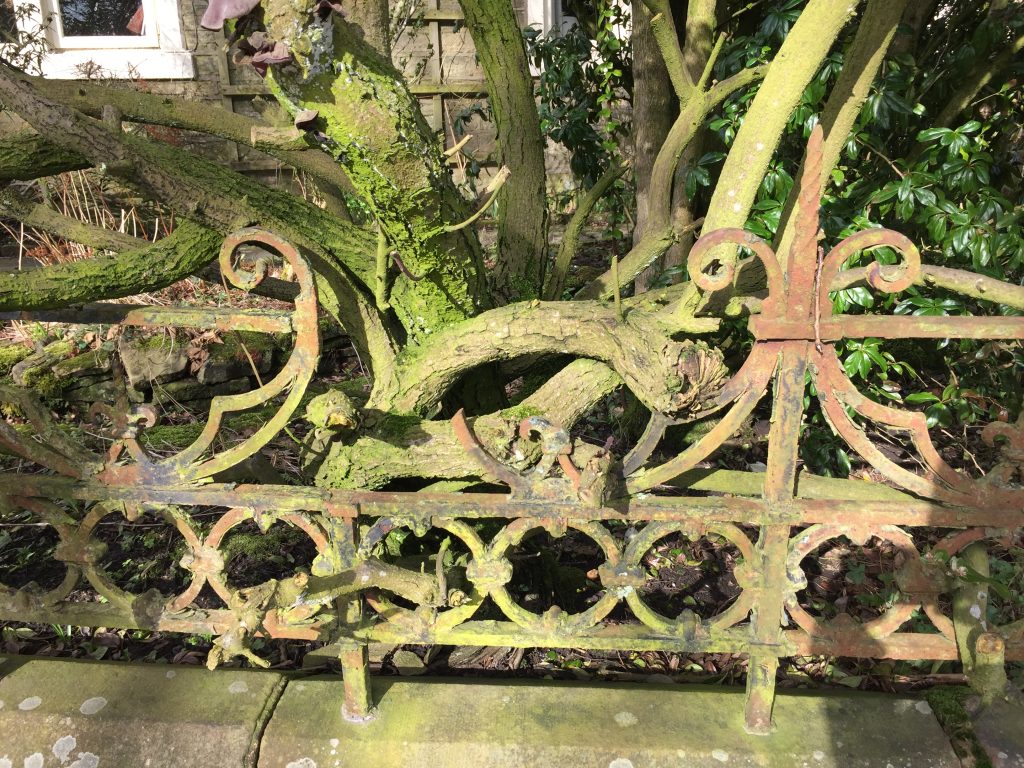
As a stopped to take a few photos of the house I noticed a beautiful wrought iron railing along the top of the garden wall. it had obviously seen better days but I thought it was lovely as it is with the early Spring sunshine bringing out the colours of the rust and moss. Then I noticed a little path to the right of the house and I thought I might be able to get a good photograph from there. I was hoping that someone from the house might come out and accost me but no such luck. What I did find, however, was quite magical. I found a walled secret garden with just one opening. I checked to see that there wasn’t a No Trespassing sign, and I wandered in. I felt as if I had fallen down a rabbit hole and found myself in a cross between Wonderland, the Secret Garden and The Shire. The photos give you an idea of the place.
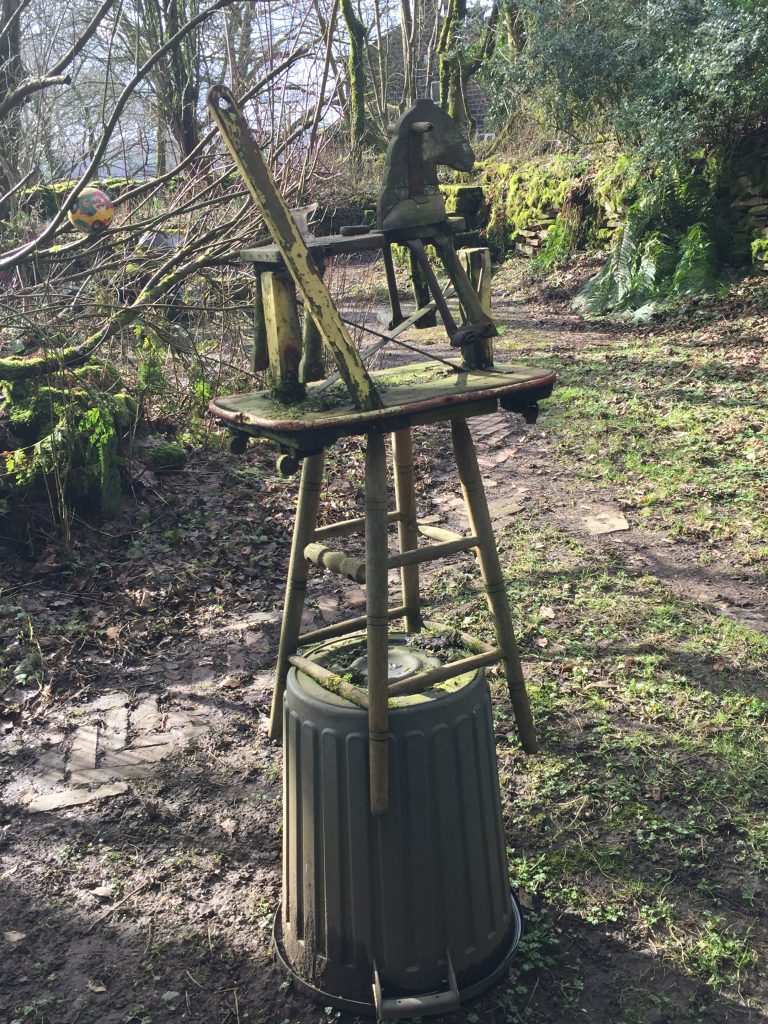
In 1851 William was still running his whitesmithing business from this house. Son Adam, 21, had followed in the family trade, while Fred, 19, was a woolsorter, and Adam, 16, was a shoemaker. Meanwhile James, who had been born in 1825, the third son, had got married to Mary Ann Ashworth, the daughter of Wiliam Ashworth, a farmer, in 1847. They would have nine children in the next 13 years. They moved into the village of Midgley, about half a mile from Foster Clough.
I found myself double checking the spelling of this hilltop village.. No wonder! Halifax parish church records 28 different spellings of this name. The village lay on the Roman Road from Manchester and was mentioned in the Domesday book of 1086. It’s situation as a hilltop village is similar to that of Heptonstall. Once the home of at least six pubs they have all gone but a village shop is maintained by volunteers. James, moved into the centre of Midgley village, opening a grocer’s shop after his marriage in 1847. It was at that time that he established James Harwood and Sons, whitesmiths. By 1861 he was living in Stocks House, a beautiful roadside cottage where I had taken photos of the current family enjoying a summer afternoon amidst their colourful flower garden, little knowing that I’d discover an ancestral connection to the property. I put a posting on Facebook and within a couple of hours I’d been contacted by someone who had lived at Stocks Farm from 1954-1972. By 1871 the whole family had moved down into the valley, right into the centre of Hebden Bridge, right onto the street where I live!
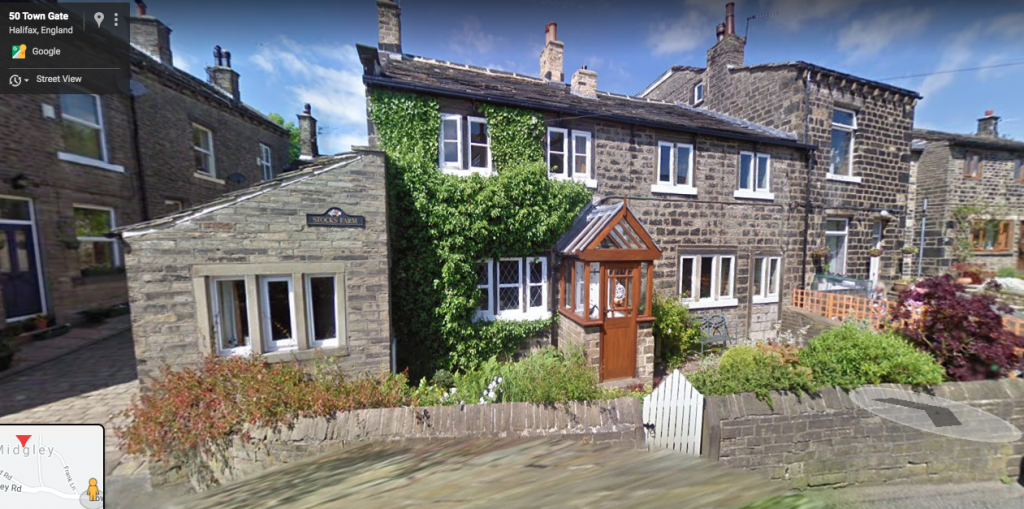
It was in this house that Edgar lived with his nine siblings until the family moved down into Hebden Bridge and by 1871 they were living on Crown Street, where I currently live. Industrial revolution migration to the valley bottoms for the mills. Edgar, only 13, and his brother James, 17, and their father were whitesmiths employing one man and two boys. Edgar was still living there in 1881 and brothers Wallace and Herbert had joined the family whitesmith business. In 1891 they were at 11 Crown street and along with his brothers they have specialized and are now shuttle tongue and tip makers. The tongue is hinged like a pocket-knife, so that it projects out from the mortise when inserting a fresh cop of yarn. I had passed this sign etched into the stonework every day for the last couple of years but I didn’t ‘see’ it until today.

Though just across the street from me I’d never seen the inscription on the wall of Boots until today 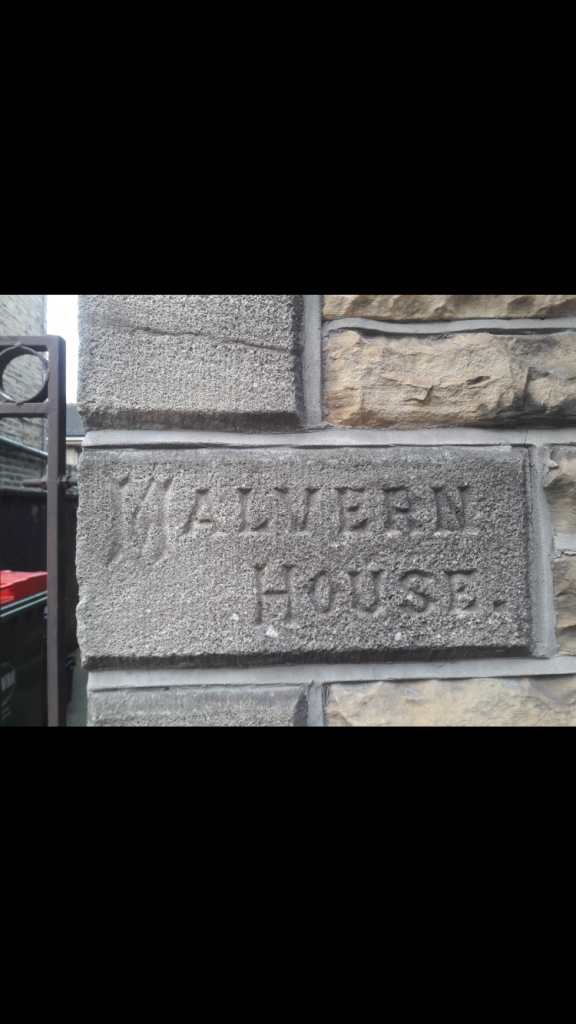
Home of the Harwoods
Meanwhile Edgar’s shuttle tip business continued to flourish. Having first been located on Crown Street in 1892 it moved to larger premises close to Foster Mill but still known as Crown Street Works.

There were 35 employees and they exported to many parts of the world. Edgar was also a figure of some standing in the community as chairman of the Hebden Bridge urban district council. In 1927 Edgar was killed at work when a grindstone burst at the Crown Street works. His brother James who worked there was the first on the scene of the accident. Edgar had been grinding peg points on a large sandstone grindstone. There was no fencing around the rotating stone because the men had to have easy access to it. Apparently Edgar had just a minute before fitted a new pulley to make the grindstone rotate quicker when a large crack was heard. An eye witness related: “Mr Harwood was lying on the ground. He had been killed instantaneously, part of his skull was blown away and part of his right hand.” An inquest revealed that the grindstone had been operating at 75% above a safe working speed but nevertheless a verdict of accidental death was returned by the jury. The funeral service at Birchcliffe Chapel was conducted by the Rev A. Windsor who had been a close friend of the Harwoods. Indeed he proffered that ‘nobody else knew him better. ‘ He described Edgar as ‘an unpolished diamond’ ‘There was a mixture of strength and tenderness in him’ The shock had been so intense for Mrs Harwood that she was unable to attend the funeral though the list of mourners and floral tributes took up an entire column in the newspaper.
One grim February afternoon with snow still clinging to the roads and a heavy cloud of fog obscured even the closest hills I came across a photograph of the former Crown Street Works online taken ten years ago. It’s entitle ‘Former Crown Street Iron Works, Spring Grove, Hebden Bridge,’ and it was with a jolt that I realized that I knew the place. It was the skeleton of a building that had attracted me since moving to the town and I found several photos of it that I’ve taken of it over the past few years. Something about it had intrigued me. It’s on a small piece of derelict land, roofless and for the past year has had a ruined car with smashed windscreen and flat tyres just outside one of the doors.
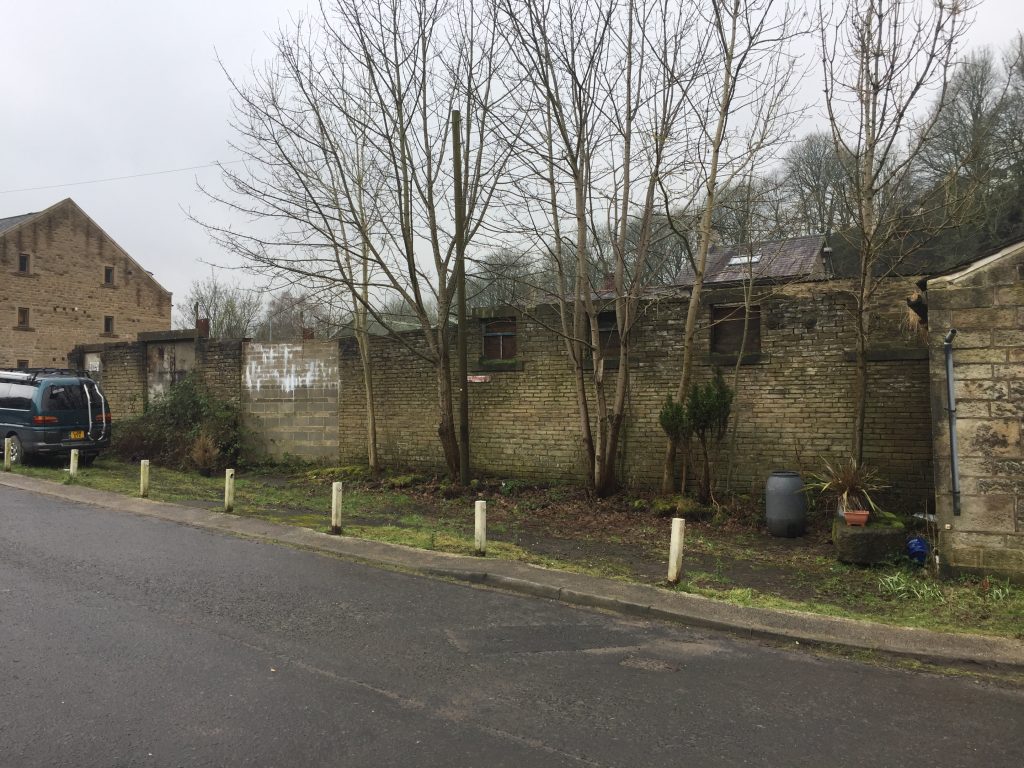
The wide double door at the side was usually firmly closed and locked, presumably to prevent people wandering in and coming to some harm but one day the door were open and I was able to see inside. There’s not much of interest, just piles of odd pallets and boxes but the week after when I passed a large architectural drawing of a smart office building adorned the main door.

Adjoining the building are the derelict stables which are currently for sale. I even made a piece of fabric art from the photograph I took of the stables. As I took a closer look at these a man emerged from a house opposite. He owns the stables which once served Foster Mill and he showed me photos of the cottages that once stood on the site of the modern houses which now form Spring Grove. My thoughts when I pass this place in future will now be filled with Edgar’s ghost wandering in this ruin while his wife’s ghost floats above Blakedean Bridge.
(see my next blog for her tragic story)
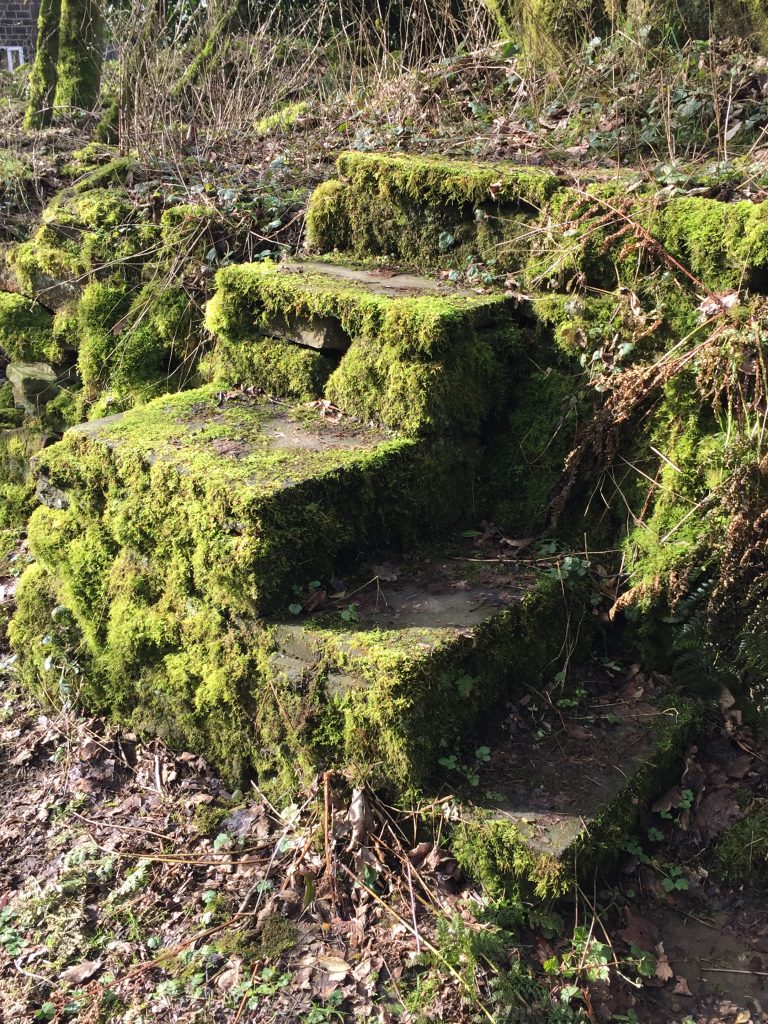
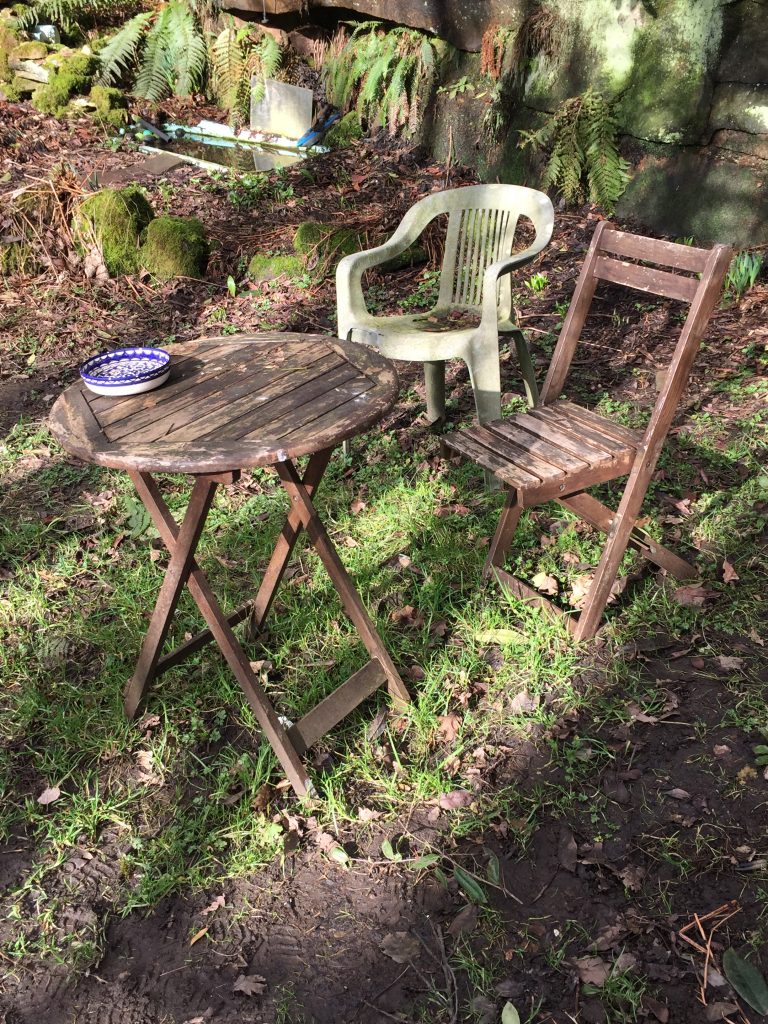
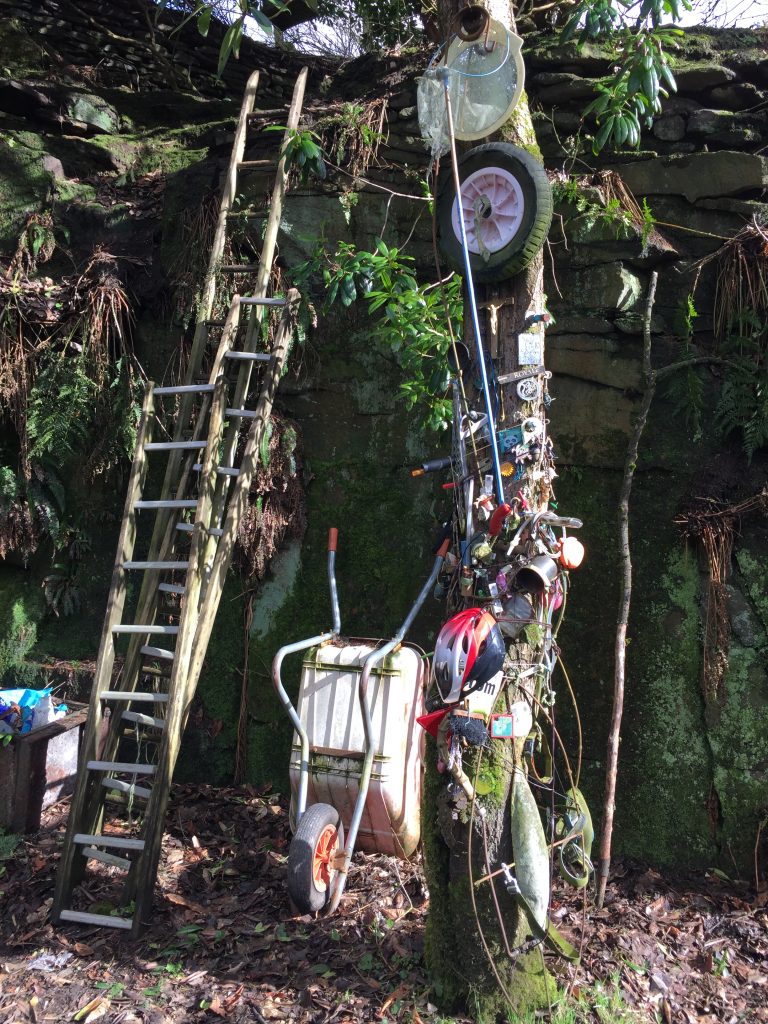
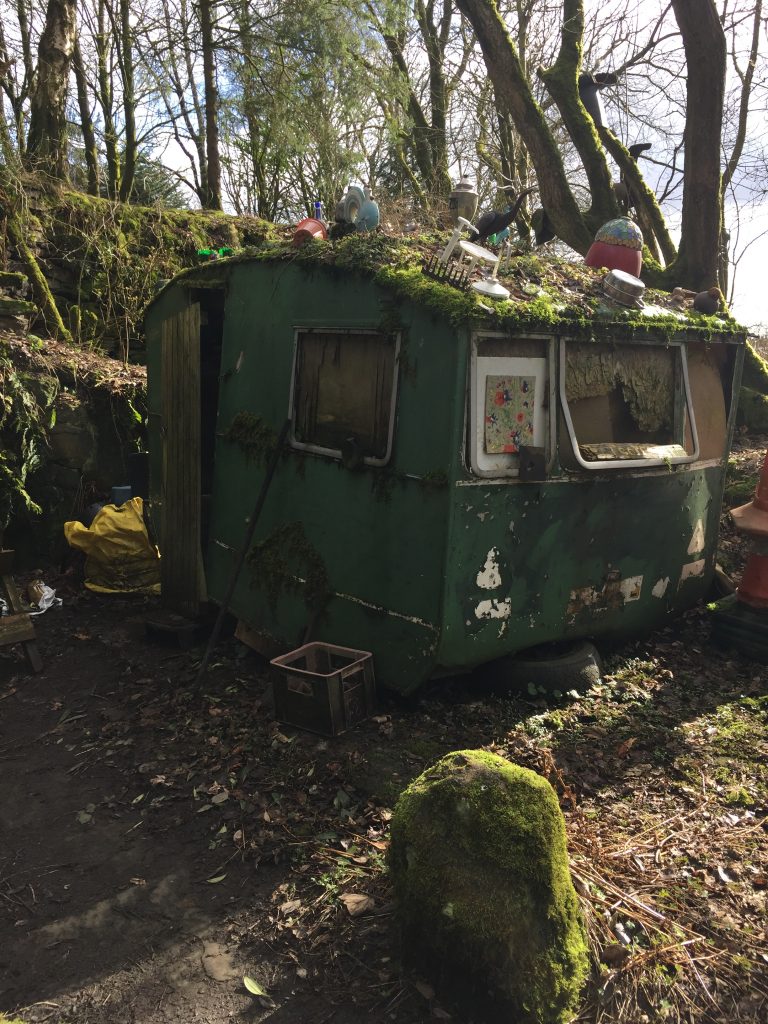
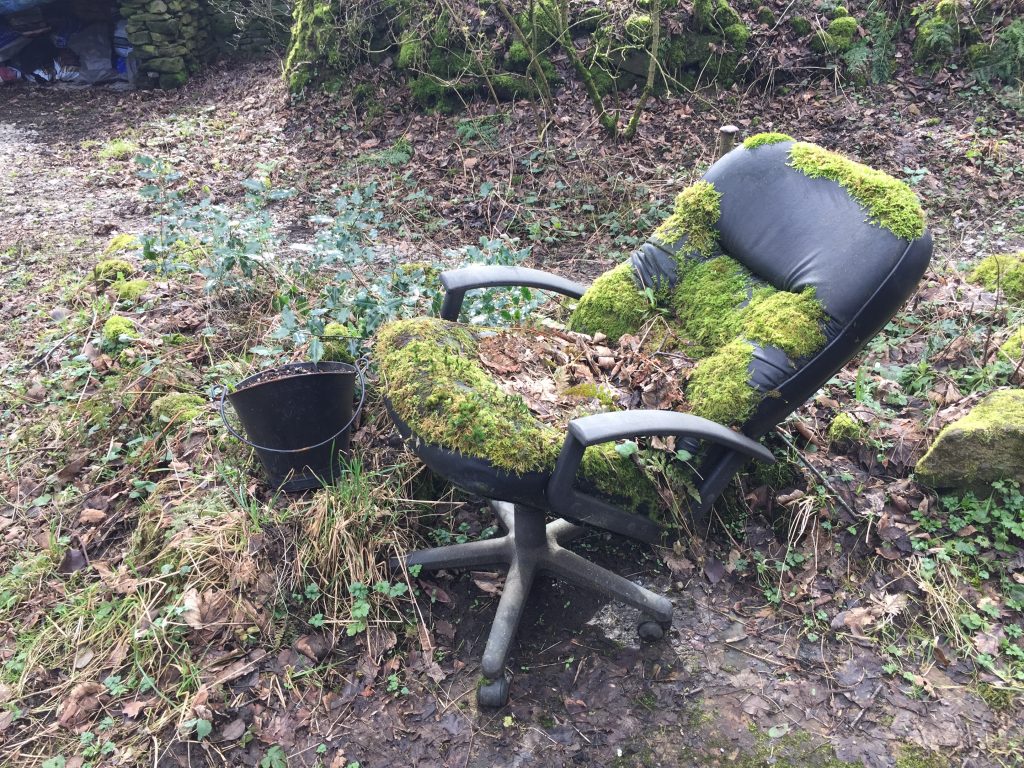
Recent Comments